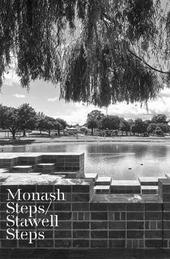
|
Monash Steps / Stawell Steps
Paperback / softback
Main Details
| Title |
Monash Steps / Stawell Steps
|
| Authors and Contributors |
Photographs by Peter Bennetts
|
|
By (author) Nigel Bertram
|
|
By (author) Hiroshi Nakao
|
|
With Virginia Mannering
|
| Series | Monash Architecture Booklets |
|---|
| Physical Properties |
| Format:Paperback / softback | | Pages:96 | | Dimensions(mm): Height 210,Width 148 |
|
| Category/Genre | Landscape art and architecture |
|---|
| ISBN/Barcode |
9781921994371
|
| Classifications | Dewey:712 |
|---|
| Audience | | Postgraduate, Research & Scholarly | |
|---|
|
Publishing Details |
| Publisher |
Monash University Publishing
|
| Imprint |
Monash University Publishing
|
| Publication Date |
1 February 2016 |
| Publication Country |
Australia
|
Description
This book presents documentation, reflection and critical analysis of two award-winning projects Monash Steps and Stawell Steps. These linked projects were designed and built by Monash Architecture students under the leadership of Hiroshi Nakao and Nigel Bertram. The works were developed in close collaboration with the town of Stawell, through partnership with local brick maker Krause bricks and civil engineers at the Northern Grampians Shire council. Monash Steps and the associated exhibition were installed at the Monash University Museum of Art in 2012, making a temporary occupiable space using dry-stacked bricks. Stawell Steps is a permanent installation on the banks of Cato Lake in the centre of Stawell. It acts as permanent flood-relief infrastructure for the town, and provides a new type of community space within the park.
Author Biography
Nigel Bertram is a Director of NMBW Architecture Studio in Melbourne and Practice Professor of Architecture at Monash University, where his current research projects address urban housing and infrastructure for water-sensitive cities. NMBWs architectural work has been published and awarded across categories including urban design, housing, small public works, adaptive re-use of existing buildings and peripheral urban design strategies. Hiroshi Nakao is Professor of Multidisciplinary Design Science at the Shonan Institute of Technology. He studied architecture at the Kyoto Institute of Technology and art at the Tsukuba University, and works across the border between art and architecture, with solo exhibitions in Tokyo, Oslo, London and Hamburg to his credit.
|